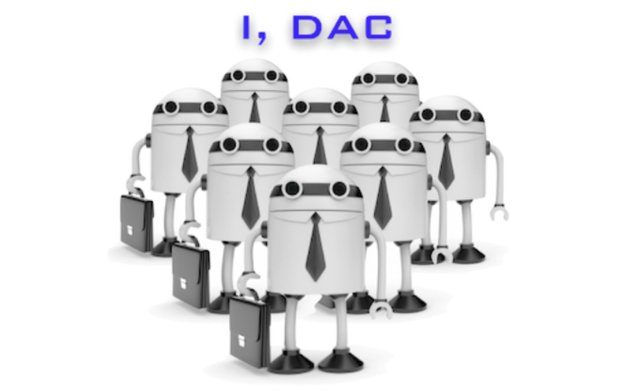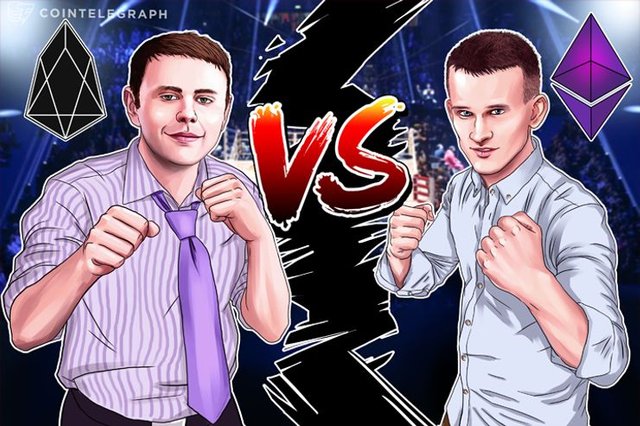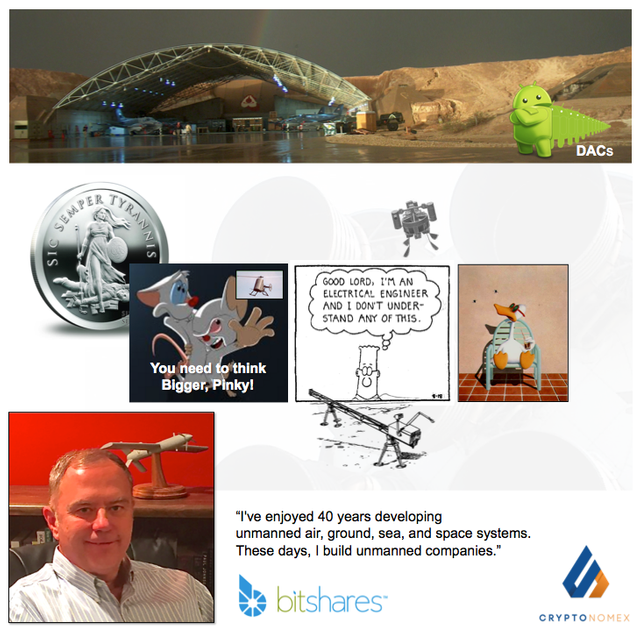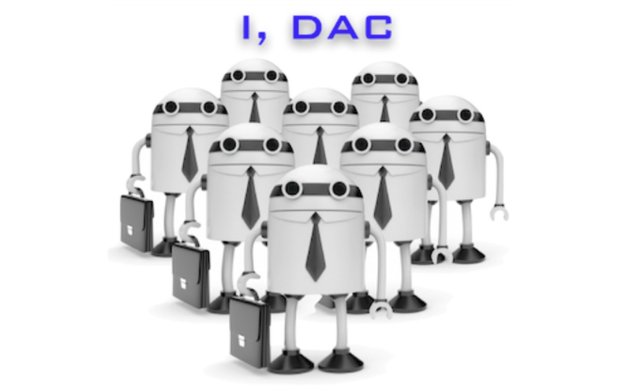Bitcoin and the Three Laws of Robotics
Five years ago on Friday I published what turned out to be the launch of a new industry - Decentralized Autonomous Corporations (DACs). Dan had coined the name a week earlier and the industry has since generalized it to Decentralized Autonomous Organizations (DAO). This old rocket scientist has come to prefer "Unmanned Companies".
Vitalik followed up almost immediately with his take on the subject and Dan revisited it just before the launch of BitShares PTS - our first prototype blockchain.
07 Sep 2013 - Overpaying for Security, by Dan Larimer
14 Sep 2013 - Bitcoin and the Three Laws of Robotics, by Stan Larimer
19 Sep 2013 - Bootstrapping a Decentralized Autonomous Corporation, by Vitalik Buterin
02 Nov 2013 - DAC Revisited, by Dan Larimer
Back then we thought it was pretty cool to put an entire unmanned company on the blockchain with BitShares - one that could issue and trade thousands of coins, not just Bitcoin. These days we are using smart contracts to put any number of unmanned companies on a single blockchain with EOS, and with BitShares EOS we'll be providing unmanned companies that can change jurisdictions see Intra-Jurisdictional Blockchains with every transaction, in a fraction of a second. You might call that "agile compliance"
I will be talking about all this in Amsterdam and Sao Paulo in the next two weeks and putting out a white paper immediately after that - right here. You should pay attention.
All of the images have broken links on the original Let's Talk Bitcoin article, so I thought I'd use this opportunity to republish it here on Steemit.

Bitcoin and the Three Laws of Robotics
Published on September 14th, 2013
You may not have considered it, but Bitcoin can be viewed as an unmanned company – or a Distributed Autonomous Corporation (DAC) if you prefer.
Unlike passive currencies, Bitcoin derives much of its tangible value by performing a trustworthy confidential fiduciary service. Essentially, it keeps private books for customer “checking” accounts and will transfer credits between accounts upon receipt of a properly signed “check”. Aren’t these some of the same private services for which Swiss banks were once famous – back when privacy was something they could really offer? Isn’t Bitcoin more like a bygone Swiss Bank than a commodity or a colorful piece of paper?
Would a DAC metaphor fit Bitcoin even better than its current coin metaphor?
Distributed Autonomous Corporations (DAC) run without any human involvement under the control of an incorruptible set of business rules. (That’s why they must be distributed and autonomous.) These rules are implemented as publicly auditable open source software distributed across the computers of their stakeholders. You become a stakeholder by buying “stock” in the company or being paid in that stock to provide services for the company. This stock may entitle you to a share of its “profits”, participation in its growth, and/or a say in how it is run.
Bitcoins can be viewed as a small “share” of the total market cap of the Bitcoin “corporation”. The “mining” services that validate transactions and secure the network are paid for in new bitcoins that slowly dilute the “stock” as the corporation’s market cap ebbs and flows. You can generally trade your shares for other currencies, goods, and services. Operating rules for the corporation cannot be changed unless a majority of stakeholders vote for them by switching to another version of the software. Interestingly, it is not the holders of existing shares that get to make this decision, but only those “employees” who are contributing their computer resources (mining bots) to run the company.
Nothing says a corporation can’t be structured to distribute voting rights this way, and that’s exactly what Bitcoin has done. Shareholders get equity growth. Employees get voting rights. All “revenue” is paid to the employees as compensation for their work. There are no profits.
Bitcoin is a shareholder-owned, employee run, not-for-profit crypto-corporation!
“Real” corporations, of course, are legal constructs created by governments so that groups of people can act as a single artificial person. But groups of people are in general no more trustworthy than individuals. Even if you completely eliminate all humans in the corporation via automation, the result will no more honorable than the rascally humans that control and maintain it. Can we construct a DAC that you would trust more than a Swiss Bank? I think Bitcoin may have found a way – with distributed autonomous software and its own Three Laws of Robotics. If you’re a true Sci-Fi buff, you already know the original set by heart:
Asimov's Three Laws of Robotics
- A robot may not injure a human being or, through inaction, allow a human being to come to harm.
- A robot must obey the orders given to it by human beings, except where such orders would conflict with the First Law.
- A robot must protect its own existence as long as such protection does not conflict with the First or Second Law.
In Isaac Asimov’s I, Robot universe, every robot was required to have these laws hard-wired into its positronic brain as a safety feature. Does Bitcoin not have analogous “laws” indelibly etched into its very core? Are not these Core Laws what make Bitcoin virtually incorruptible?
The critical innovation with distributed blockchain systems like Bitcoin is their ability to credibly implement their own set of incorruptible Core Laws.
Any set of business rules could be implemented by a DAC, even those most would consider evil. The key idea is that the Core Laws ensure that a chosen set of business laws are burned-in, immutable, and incorruptible. If you like a DAC’s incorruptible business rules, you can rely on them. If you don’t like them, don’t do business with them. But you can never be betrayed.
DACs can still be designed to have a robotically inviolable intention to rob you blind, but to enter the open source arena they must be honest about their plans to do so.
What Core Laws should DACs implement and how would they do it? Here’s my stake in the ground, with apologies to Dr. Asimov:
Three Laws of Robotics for Distributed Autonomous Corporations
- A DAC must always obey its own published business rules.
- A DAC must never change its rules without consent of its stakeholders, except where such change would conflict with the First Law.
- A DAC must protect its own existence, as long as such protection does not conflict with the first two laws.
In actual practice, these Three Laws are embedded into open source software for all stakeholders to inspect. They govern the protection of the rights of stakeholders and how other rules can be changed, but they themselves can never be changed.
The First Law, integrity, is enforced by cross checking every DAC node’s actions with many other DAC nodes (i.e. bots). Rogue actions by individual DAC bots are simply blocked by the collective and their perpetrators shunned. Rule disobedience is futile. Coercion by nefarious agencies is futile.
The Second Law, incorruptibility, ensures updates to any DAC source code are not incorporated without consent of a majority of stakeholders. Unless more than half of the total collective work force agrees to adopt it, corrupting even a large minority of DACBOTs will have no effect.
The Third Law, self-preservation, covers features engineered to harden the software against very real threats to a DAC’s existence. The first two laws already mitigate the introduction of bad bots into the collective. Open source software has thus far prevented corrupt agencies from introducing corrupting “features”. But a more serious risk is any persistent tether to a DAC’s human creators who must necessarily remain exposed to all the corrupting influences that flesh is heir to. Such tethers are easy to exploit by shutting down web addresses, passing laws, proliferating regulations, issuing injunctions …or much darker methods. Attacks against a DAC’s creators remain its Achilles’ heel. To survive as trusted entities, DACs must become internationally autonomous.
Implementing the Three Laws of Robotics for DACs will be a never-ending arms race.
Asimov had the enviable privilege of decreeing his Three Laws as a fait accompli. In the cold, cruel real world, we must tend to the engineering details. Integrity, incorruptibility, and self-preservation technology must evolve with the escalating threats against them. To stand still is to be overrun.
One obviously needed self-preservation strategy would be to include with each DAC’s distribution package a massively distributed ability to propagate that distribution package. DACBOTs need to be able to clone more identical DACBOTs without the interdictable support of their creators. Another desperately needed innovation is a better way to introduce inevitable software updates that affect all DACBOTs. Software updates generally rely on trusting the developer. But now, it is way too likely that any trusted DAC provider will be shut down, prevented from offering its software, or seduced/coerced into installing back doors for Nefarious Secret Agencies in their next maintenance release. Developers are, after all, only human.

Steely-Eyed Geeks (Homo Technosapiens)
To date, Bitcoin has been well protected from such Trojan horses by its open source policy and a worldwide network of anonymous, independent Steely-Eyed Geeks (SEG) who would love to be the first to blow the whistle. Unfortunately, Steely-Eyed Geeks are a scarce resource that must be attracted like antibodies to a DACs defense. As DACs proliferate, novelty and fame will be less effective in attracting such resources. So DACs will need to find ways to autonomously compensate their human defenders. Direct hiring by the DAC’s creators would expose SEGs to the same seduction and coercion risks. To be effective, SEGs must remain motivated, anonymous and independent. Distributed Autonomous Corporations need a SEG benefits package!
Ultimately, to achieve complete incorruptibility, developers must be willing to let go of their own control. If there remains any centralized human control anywhere, it will eventually be exploited to the detriment of the DAC’s stakeholders. DACs need to be free to be trusted.
“Centralization tends to corrupt, and absolute centralization corrupts absolutely.”
Bitcoin has already demonstrated its ability to credibly implement a social contract based on a rudimentary set of inviolable Core Laws. We are betting that, having recognized they are in an arms race, developers will continue to out-distance the necessarily reactive forces that will try to corrupt them. Put another way: “incorruptibility is a necessity and necessity is the mother of invention."
DACS with superhuman robot honor are inevitable. It’s their unique competitive edge.
The Future of DACS
The DAC metaphor seems to be helpful in appreciating the revolutionary nature of blockchain technology. Its not just the sine quo non of digital currency, it’s a way to implement incorruptible business relationships of almost any kind. Adopting this new metaphor is like the difference between using a flat earth or a sphere as your model for planning global shipping routes. All sorts of new insights open up when we tap our prior experience about how market-driven corporations work in the physical world. Lets go there in two steps: First, try to imagine the value of a corporate entity you can design to have robotically inviolable fiduciary regard for the interests of its customers and stakeholders. Second, lets consider how to make it operate like a traditional corporation optimized to compete with its shifty human peers.
Step 1: Recognize the nature of the beast. Relentlessly honorable autonomous corporations would have many advantages in the free market. Like Bitcoin, DACs armed with a set of inviolable Core Laws are far safer to deal with than corruptible human organizations. Moreover, such entities have emergent characteristics with far more interesting applications than just keeping the books for a crypto currency. Blockchain ethics allow a suitably motivated engineer to “incorporate” some or all of the following SEG-verifiable characteristics.
They are corporations – They are, and of a right ought to be, free and independent persons.
They are autonomous – once up to speed; they no longer need (or heed) their creators.
They are distributed – there are no central points of control or failure that can be attacked.
They are transparent – their books and business rules are auditable by all.
They are confidential – customer information is securely (and incorruptibly) protected.
They are trustworthy – because no interaction with them depends on trust.
They are fiduciaries – acting solely in their customers’ and shareholders’ interests.
They are self-regulating – they obey their own rules like, well, robots.
They are incorruptible – no one can exercise seductive or coercive influence over them.
They are sovereign – over their digital resources. They don’t need governments to exist.
Collectively these imply that:
DACs don’t need regulation, you don’t want to regulate them, and happily you can’t.
A DAC can be introduced into the wild from anywhere in the world and will spread on its own to wherever its services are appreciated. It will survive if it is well adapted to its market environment and perish if not. Its creator can improve its survival odds by promoting it and defending it up to a point. But the umbilical cord should be quickly severed since its creator remains exposed to the risks of the real world.
This is not to say that DACs are above the Law of the Market. Such natural law is the most legitimate source of regulation. If a DAC doesn’t provide trustworthy value in the marketplace, it will be shunned and die of neglect. If its published social contract and the services it offers don’t make it a desirable business partner, it will perish.
In the end, a DAC’s survival depends on the willingness of others to engage in voluntary exchange with it. DACs, like people, will develop reputations. The Core Laws make sure that once a reputation is earned, it can be counted on to persist. History is littered with human organizations that started out with high ideals like “We the people” or “Don’t be evil” only to succumb to ethics rot as flesh and blood executives are seduced and/or coerced. Inviolable DAC ethics can start out bad, but they can’t rot.
Like the industrial and Internet revolutions before it, the DAC revolution will be a boon to those jurisdictions that restrict it the least. Would-be regulators can’t stop the world’s truly free markets from adopting it. They can only make it harder for their own hobbled markets to benefit. Perhaps that’s a price they are willing to pay for power.
Regulation by force, like the use of antibiotics, will only lead to new, more resistant strains.
Namecoin, Mastercoin, BitShares and other “crypto-entities” already share many of these characteristics though some may not fully realize it. New insights and design patterns can be gained by recognizing (and perhaps standardizing) the DAC metaphor. Such standards (and a good benefits package) will focus and conserve critical and limited Steely Eyed Geek resources.
Step 2: Exploit the utility of the beast. Technologies for making impeccably honest and tamper-proof software are only valuable if the software does something useful. If we use a currency metaphor, we can invent better currencies. If we use a corporation metaphor, we can invent almost anything. A DAC is a company and can work in many ways like those of brick and mortar and flesh and blood.
- It can raise capital by selling shares of its stock … and pay dividends.
- It can raise capital by borrowing against its stock … and pay interest.
- It can raise capital by providing services of value to its customers.
- It can use stock to pay persons (human or artificial) for resources and services.
- It can use Internet APIs to automate access to its products and services.
- It can adapt its business processes in response to market feedback.
- It can use stock transfers to (fairly) reward or penalize the behavior of others.
As a DAC performs fiduciary services of value to others it generates real wealth that can be stored and transferred via its own stock. But, as Clint Eastwood might say, “a DAC’s gotta know its limitations.” A sovereign DAC has no way to accept, hold, or remit physical commodities or fiat currencies and still remain independent of external forces. Further, an open source DAC can’t keep a secret. It can securely hold encrypted data for others, but it has no place to keep a private key of its own. Thus, a DAC can’t have its own crypto wallet full of blockchain assets.
So it works best when creating or transferring value entirely within the DAC domain. This is not to say that humans can’t trade real assets among themselves in exchange for rights to a DAC’s shares, or that a DAC can’t participate in the allocation and tracking of those rights. But its sovereignty extends only over the contents of its own blockchain.
Here are some notional DACs that might well appear in the coming year …or decade. Naturally, their corporate names in the DAC Domain would end in DAC, not INC, LTD, or LLC. (Folks will want to know if they are dealing with a Corporation of Superhuman Integrity.) The common denominator is they all exploit an emerging competitive edge:
DACs trade on their incorruptible ability to apply transparent rules to secure data.
Reputable Monikers, DAC - Manages rights to an identity namespace.
Robo Courier, DAC - A secure electronic courier service.
TradeBitShares, DAC – Robotically honorable banking and brokerage services.
Unmanned Escrow, DAC - Escrow services that conditionally transfer ownership rights.
Virtual Ventures, DAC - A crowd-sourced venture capital firm.
Autonomous Arbitrators, DAC – Incorruptible arbitration services.
DAC Installers R Us, DAC - Trustworthy auto-installation of consensus-based DAC updates.
SkyNet, DAC – A swarm of DACBOT satellites implementing a unbuggable new Internet.
One World Government, DAC – A government that can't ignore its own constitution.
I’ll quit before I get carried away. The point is, changing metaphors opens up unlimited new possibilities. You’re not limited to just another altcoin. What earth-shaking, paradigm-busting DAC could you release into the wild?
Bottom Line. Metaphorically, the concept of a Distributed Autonomous Corporation is a helpful way to understand the much greater potential of the technology pioneered by Bitcoin. By moving from the metaphor of a digital currency to one of an incorruptible unmanned business, revolutionary new entities can be envisioned. Unlike their flesh and blood peers, DACs will be sovereign corporations governed with inhuman integrity.
And that should make all the difference.
About the Author

This is seriously important stuff. Some parts of the world are mired in such horrid levels of corruption that they can hardly be called functioning societies. The greater proportion of co-operation between humans takes place in the digital realm the greater impact DACs can potentially have to transform these parts of the world for the dramatically better.
Haha Homotechnosapiens - now that’s a word I’m sure going to use in the future
To listen to the audio version of this article click on the play image.

Brought to you by @tts. If you find it useful please consider upvoting this reply.
Great article. Upvoted and resteemed. What do you mean by Bitshares EOS @stan? Will it port over to EOS, what about EOSfinex? Thanks
It seems that Bitcoin might be already struggling with centralisation.
I believe you are in Utah this weekend at a Quintric conference. I finally caught the @bluerock Video last night. I believe the Scriptures and God's use of prophecies to proclaim the Messiah was obviously a most "followable" method of transparently producing quality "content' to set markers for the "coming". So in the fictional universe of corporational "persons" we can look for the promise of an integrity based model to arrange our contemporary "benefits" package that includes a way to live in the "world" and yet not be a part of it.
I have longed for the processes of sound monetary exchanges for several years now and stumbled across the Utah Precious Metals Association while on that search. I was listening to the clues and am going to dive down the rabbit hole of the jurisdictional properties you are helping us with.
I can follow the clues better now that I have seen more from the "beginning" (last nights view of the @cryptoconnies recorded - 2 hour broadcast). I have used a phrase for many years to involve any readers of my "reasons" for my faith in an incorruptible system of government and labor. I have always said "thanks for listening". I will be changing that to "whoever has ears let him hear". I consider myself to be a part of the "remnant" and am both "honored and humbled" by the "promise".
I am a follower of truth into the "wild" open source coliseum. If confession of this is my partipatory life then I accept the name.
I will be able to watch the live program with the remaining clues this week on the "tube".
Whoever has ears to hear, let him or her hear.
just changing the metaphor really can bring a new horizon to the crypto.
Coins mentioned in post:
thanks so much for sharing @stan.
I like 3

Excellent article thank you